George M. Cohan tries his hand at the silent screen in this adaptation of his hit play. He plays a schlock writer who wagers he can create work of literature in 24-hours. Our hero goes to an isolated and deserted inn to work but of course you know he will be interrupted. By a reporter. And criminals. And a crazy hermit. Who steals corpses. Because.
I shall also be covering the 1983 remake, House of the Long Shadows. Click here to skip to the talkie.
Yankee Doodle Deadly.
George M. Cohan was the toast of Broadway with numerous musical hits but his most popular play was an adaptation of a 1913 novel concerning the exploits of a writer, a reporter and a mysterious inn. (You can read a public domain copy here.)
Seven Keys to Baldpate is a rare chance to see Cohan when he was at his peak and it is the only one of his three silent films to survive. (You can safely discount the spurious reviews of Cohan’s other silents that are found on IMDB. They were written by the infamous F. Gwynplaine MacIntyre.)
So, can Mr. Cohan charm us without his voice? Looks like we are going to find out!
The story opens at a stylish resort where everyone is hopelessly hooked on the latest novel from noted schlockmeister George Washington Magee (George M. Cohan). Magee’s friend, Hall Bently (Frank Losee), feels that he is wasting his talents on cheap melodrama when he could be creating real art. Magee scoffs at the notion that his thrillers are inferior. He bets $5,000 that he can create a book about “real” people in 24 hours.

Bently accepts the bet and offers the use of Baldpate Inn, which he owns. The tourist season is not for another month and it is quite empty. Perfect for concentration. It’s all settled and soon Magee is in Baldpate with the only key in his pocket. Meanwhile, intrepid reporter Mary Norton (Anna Q. Nilsson) gets wind of the bet and follows Magee, hoping for an interview. He refuses as he has no time to spare but promises her all the time she needs once his deadline has passed.

Magee sits down to write but is soon interrupted by someone opening the door of the inn… with a key. The intruder, called Bland (Purnell Pratt) makes a telephone call and Magee overhears him saying that he has $120,000 in bribe money hidden in the inn. It is meant for someone called Mayor Cargan.
After a furious fight and very nearly getting himself shot, Magee manages to lock Bland upstairs but before he can call the police, he is interrupted by Mary opening the door with another key. Mary is accompanied by Mayor Cargan’s fiancée, Mrs. Rhodes (Corene Uzzell), who hopes to prevent him from taking the bribe. Magee delays calling the police so he can flirt with Mary.

Look, if some guy tried to shoot me and I had him locked upstairs, nothing on heaven or earth would stop me from calling the police. I wouldn’t call Magee brave so much as stupid. Anyway, Magee is interrupted again by Peter the Hermit (Eric Hudson), an eccentric who likes to pretend to be a ghost and who, you guessed it, also has a key. Then Myra Thornhill (Hedda Hopper, billed under her much-better real name of Elda Furry) shows up, she has also nearly been shot and has her very own you-know-what. She is the wife of the guy who provided the $120,000 and she means to get it back.

Confused yet? I guess I can shorten everything up by writing that what with one thing and another, a large group of strange individuals with conflicting and colorful stories show up at the inn. Much intrigue is afoot.
Seven Keys to Baldpate is not a bad movie. However, other than Cohan’s presence, it really does not have much to distinguish it from the other offerings from the same period. The atmosphere is not particularly menacing, the lighting and direction are flat and uninteresting. Director Hugh Ford started out in 1913 and it shows. While other directors of the period, such as Lois Feuillade and Cecil B. DeMille, were creating dangerous dream worlds, Ford seems content to plunk down the camera and let it roll.

The film is not a total loss, though. Let’s name some good points. Anna Q. Nilsson is not given a huge amount of stuff to do but she is, as always, charming and natural. Hedda Hopper and Corene Uzzell fare better, both are portrayed as capable and intelligent players in this bizarre plot.
But then there are more flaws and the list is long. No one has a bit of peripheral vision. Further, the whole cast goes about informing one another of things they already know just for the benefit of the viewer. It’s very clunky. Finally, the characters keep forgetting that they are in possession of a working telephone, an invention that must have been a real game-changer for the hoary melodramas of the period. (In modern times, the popularization of the cell phone was the greatest disaster to befall the motion picture industry, second only to the end of the Cold War.)

Finally, the movie becomes less of a thriller and more of a study in unintentional humor when Hedda Hopper gets shot and Peter the Hermit spends the last part of the film reenacting Weekend at Bernie’s with her body. I am not making this up. He hauls her corpse hither and yon, trying to escape detection.
One of the big selling points for the story is its twist ending. (Which I am now giving away. Please skip ahead if you wish to be surprised.) You see, the action and adventure were all part of Magee’s novel. He never left his room in Baldpate inn. This is one step above “it was all a dream” and I am not afraid to say that I was underwhelmed. Plus, he was supposed to be writing something other than a cheap thriller so he writes… a cheap thriller?

Regarding our leading man, Cohan does all right, certainly better than some of his stage contemporaries but his charisma does not really transfer to the silent screen. Unlike Geraldine Farrar, who compensated for the loss of her famous soprano voice with some flashy acting, Cohan just sort of acts the same way he probably did in the stage play. It doesn’t really work.
Further, his pale blue eyes seemed to have caused problems. You see, orthochromatic film, which was used until the twenties, did strange things to blue eyes. As in, it simply did not register them. Some blue eyes were dark enough to show up but very pale blue and grey eyes could disappear, leaving only the whites and the pupil. These dead eyes worked fine for, say, Conrad Veidt, who made his career in horror and villainy but they proved to be a real problem for actors like Stan Laurel, who wished to charm their audiences and not terrify them. I think this issue accounts for the relatively low number of close-ups Cohan has, as compared to his co-stars, and even fewer scenes of him looking directly at the camera.

Seven Keys to Baldpate is pretty generic, as silent thrillers go. If you are in the mood for something Old Dark Housey, I suggest The Cat and the Canary. If you want a good movie with a scribe as the hero, try The Power of the Press, directed by Frank Capra. If you want a stylish silent thriller, I recommend anything directed by Louis Feuillade. Seven Keys is interesting for a historical standpoint but it is not good enough to seek out on its own merit.
Movies Silently’s Score: ★★½
Where can I see it?
Seven Keys to Baldpate is available on DVD. Alas, no really high quality prints seem to have been released.
For this Silents vs. Talkies event, I had an embarrassment of riches. Which remake would I cover? The 1929 early talkie starring Richard Dix? The 1935 remake? Or the 1947 one? No, I settled on the 1983 version, entitled House of the Long Shadows. Why this version? I had four reasons. Christopher Lee, Peter Cushing, John Carradine and Vincent Price. Yes, all four in the same movie, sharing scenes and generally acting sinister. How could I refuse?
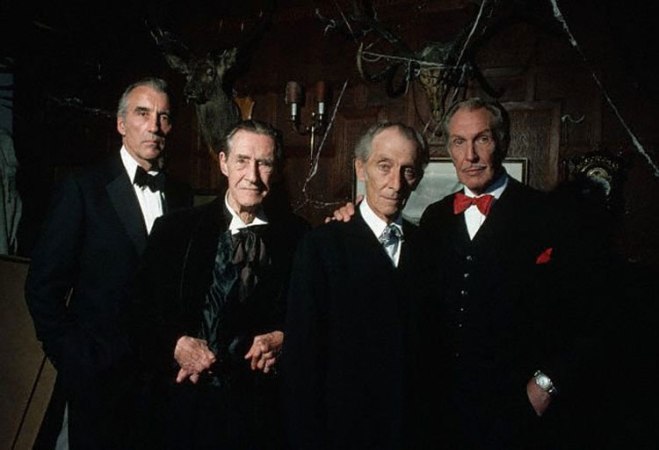
Sadly, we have to wait for our horror veterans. It seems that even though gathering these talented men together was the main purpose in making this film, we must first be introduced to our… well, I guess “hero” is the word.
The movie starts with Kenneth Magee (Desi Arnaz, Jr.), an American writer whose scuzzy books have quite a following in England. Magee’s agent (Richard Todd) encourages him to turn his talents to more worthy endeavors. Magee scoffs at literature, specifically Wuthering Heights, and bets that he can write something just as good in 24 hours. (I find this incredibly obnoxious and I don’t even like Wuthering Heights.) The bet is on and Magee is given use of an ancient manor in Wales.
Rather than simply being Baldpate, the manor is given an arm-long Welsh name that ends up being pronounced in a manner rather close to Baldpate. Making fun of long Welsh words? How original! What a thigh-slapper! Any other ethnic humor you would care to trot out? Some kilt jokes, perhaps? Or a few digs at the French eating garlic, frogs and snails? Golly, these jokes are just as funny now as they were when they were invented back in 1531. The fact that the Welsh language was subjected to extermination attempts makes it even more humorous!
Anyway, our annoying Mr. Magee heads out to Wales and soon realizes that the manor is not as empty as he was led to believe. Mary Norton (Julie Peasgood) shows up trying to convince him there is a spy ring operating out of the house. It turns out Magee’s publisher put her up to it as a practical joke but then things take a more sinister turn.
One by one, the surviving members of the old Grisbane family have arrived for a family reunion. First, there is Lord Grisbane (John Carradine) and his daughter, Victoria (Sheila Keith). Next come the two sons of the family, timid Sebastian (Peter Cushing) and bombastic Lionel (Vincent Price). Finally, the man who is buying the estate, Corrigan (Christopher Lee), arrives to find out just what all these people are doing in the house.
The story borrows heavily from the classic The Old Dark House (indeed, director Pete Walker attempted to secure the remake rights and only turned to Seven Keys to Baldpate when this proved unsuccessful) and also includes a good number of references to earlier horror films.
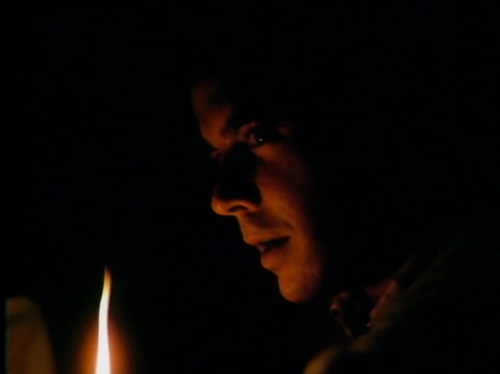
Both The Old Dark House and House of the Long Shadows are set in Wales and concerns the exploits of a family with all its members, frankly, off their rockers. The family dynamic is also identical to that in The Old Dark House, except for an additional sibling. We have an elderly father, religious sister, one brother locked away and two free. (Only one free brother in the 1932 film.) The Old Dark House is splendid, by the way. Do see it.
Here is a rundown of the mature cast in the order that they appeared in the picture:

John Carradine plays Lord Grisbane and has the least screen time of all the legends. Still I thought he was rather good as the frail but vaguely threatening patriarch.
Sheila Keith is excellent as the hyper-religious daughter of the family. She brings a fiery fanaticism to the undertaking. A shame that she also shuffles off the movie’s mortal coil relatively early.
Peter Cushing is timid and fluttering as the sensitive Sebastian, the only member of the Grisbane family who seems to have any conscience about the family’s secret. You see, the youngest son of the family, Roderick, committed an unspecified crime when he was fourteen so the Grisbanes locked him away in his room. For forty years.
Vincent Price absolutely gnaws the scenery as Lionel, the oldest son and de facto head of the family. Mad, menacing and loquacious, he is easily the most colorful member of a very colorful family.
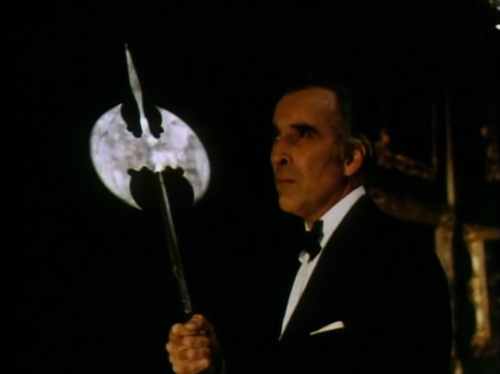
Christopher Lee plays a very understated role for much of the film but when he lets himself go at the grand finale, it is a wonderful sight to behold. (Spoiler: In the Cushing-Lee films I have seen, Cushing has been well ahead in the “who kills who” game. This time, it is Lee who kills Cushing. I just wish he had been able to finish the job with Arnaz.)
Under this onslaught of ham, Desi Arnaz, Jr. withers. Few could withstand it. The combined forces of Carradine, Price, Cushing and Lee? Basically, Magee spends the film vacillating between solving the mystery and writing his book, whining about whichever option he is currently taking. It didn’t really matter because I couldn’t possibly have cared less. I wanted more of those wonderful veteran actors, the ones who were making horror with Arnaz was in training pants. Any scenes without them are a write-off.
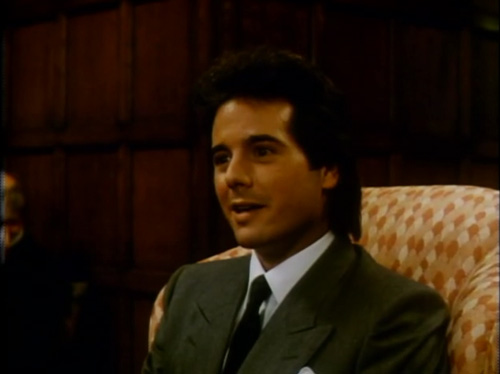
I can’t entirely blame Arnaz for his so-so performance because his character is just so horrid. (I do, however, blame him for the Reagan-era feathered mullet. Ugh!) Magee is rude, obnoxious, vulgar, sniveling and generally unlikable and yet the story treats him like a lovable rogue. (Maybe this was meant to poke fun at vapid horror heroes but if that was the case, they did their job a little too well. More on that in a bit.)
On the plus side, I thought Julie Peasgood was likable and appealing as the determined Mary, though she does share Arnaz’s misfortune with eighties hair. I would have preferred to have her as our protagonist and eject our horrid writer entirely.
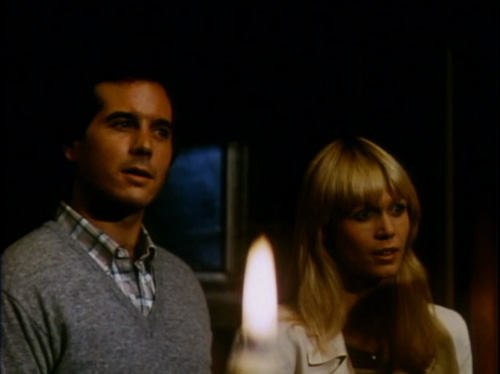
The script has the characters fall into the horror movie clichés immediately. A homicidal maniac about? Ladies, this is your cue to strip to your undies. Oh, and gulp down some beverages from an open punch bowl, I’m sure it wasn’t tampered with. Most ridiculous is the scene where Magee declares there is safety in numbers and then everyone agrees to split up. Supposedly, this movie was intended as a parody of horror tropes but was then recut to make it a more straightforward horror film.
The problem with this should be obvious. If a movie is jam-packed with movie references and tongue-in-cheek inclusions of horror clichés, removing humor just makes those clichés look clueless instead of clever and the movie references derivative instead of a winking bit of fun. When lampooning a genre that is naturally over-the-top—and what genre is madder than horror?—there are enormous risks. How crazy do you have to be to convince audiences and critics that this is not a serious endeavor?

Another problem is that if all the humor is based on references to older horror films, some quite obscure, then the film-makers could hardly expect mass audience appeal. In order to gain a mass audience, spoofs have to either target something universally known and universally popular (Star Wars, Casablanca, etc.) or they must target something brand new, preferably a film made in the last year.
But suppose the screenwriter’s heart is set on a more obscure film or films? Then the jokes must be clever enough to stand even if the viewer has never seen one foot of film from the target movies. For example, Airplane! created much of its humor at the expense of a 1957 movie called Zero Hour!—even lifting dialogue as-is from the latter film’s clueless script. However, the jokes were also funny just as themselves. There was no need to see Zero Hour! in advance.

How much of this failure is due to the script and how much is due to editing? There is no way to know but the fact remains that the comedy angle is just not that obvious, especially for audiences who are only casual viewers of classic horror.
Oh and a note to British writers who wish to include American characters: Americans collect cans. They collect for charity. They collect stamps, coins and figurines. They use their telephones to call collect. What they never do is collect people and they never, ever say “Call by in the morning and collect me.” I am certain that American films put all sorts of ridiculous phrases into the mouths of English, Irish, Scottish, Australian and Canadian characters but that is no excuse. (I should mention that screenwriter Michael Armstrong apparently had to finish the script in two weeks and was allowed relatively few rewrites.)
Desi Arnaz, Jr. is a real Yank, of course, so at least his accent is the ticket. I am eternally amused when British productions have American characters sound like Nebraskans with adenoidal discomfort and a wired jaw. Or whatever the heck this woman is doing. Again, turnabout is fair play and Hollywood has had its share of agonizing accents from the old country but my word!

The one fatal blow to this film, though, is the cinematography. It is appalling. Look, I know this is an old dark house and whatnot and that there is no electricity and that moody lighting can set the stage… BUT, I object to the screen being pitch black for long stretches, obscuring the action when it serves no purpose. By the midpoint, I was ready to offer the characters a flashlight. This is not setting the mood. This is incompetence.
And then there is the ending. (Spoilers in this paragraph) The film boasts of three major plot twists. The first is easy to guess. Corrigan is Roderick. Anyone can see that from the start. One does not cast Christopher Lee just to stand around and invest in real estate. (But why did his family not recognize him, while Magee is able to guess his identity from a moldy, decades-old portrait seen in flickering candlelight?)
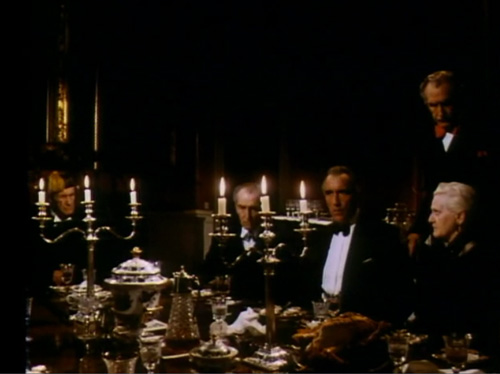
(More spoilers) The second twist is that everyone is an actor, hired by Magee’s publisher as an elaborate practical joke. This is a bit harder to swallow as the performers remained in character even when there was not logical reason for them to do so. However, if the movie had ended there, it would have been okay. I liked the idea of Magee being made to look a fool. (Stop the movie about 6 minutes before the ending and see how well it works.) But then one more twist: everything that happened after Magee arrived in Wales is actually his novel. It was all in his head. It was all a dream. Boo! Hiss! Yes, I realize that this ending was from the original Seven Keys but it wasn’t even very good there. After taking to many liberties with the story, why include such a weak element? Plus, this is the book that is supposed to be better than Wuthering Heights? Please!
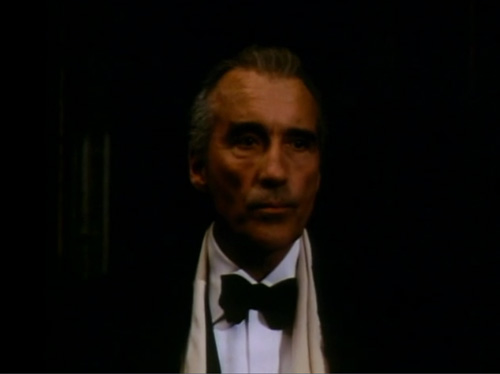
I try to give movies I review every chance (but heaven help them if they tick me off) so I decided to call in reinforcements for this one. You see, I am not really the target audience for any classic horror-related humor or in-jokes so I consulted with someone who is.
My blogging buddy Jo celebrates all things classic and scary over at The Last Drive In and she kindly agreed to view House of the Long Shadows and give me the perspective of a serious fan of old-school horror. Her verdict? Pretty much the same as mine. Not all that funny. She caught a lot of movie references, Poe references and director Pete Walker’s self-references. Still not all that funny. In her words, a waste of nostalgic talent. (Thanks for the help, Jo!)

Our four veteran actors, plus Julie Peasgood and Sheila Keith, all deserved better than this. What could have been a ripping bit of fun is hampered by bad lighting, an unappealing protagonist and too little time on the screen for these six talented performers. The last-minute cuts apparently destroyed the intended rhythm and tone of the picture, leaving a very uneven product that does not know whether it is a comedy or not. The House of Long Shadows is still worth seeing, especially for mega-fans of Hammer horror, but it is a bit of a disappointment.
And the winner is… The Talkie!
For all its flaws, House of the Long Shadows is the more interesting film. While Seven Keys to Baldpate can be a bit of a slog, House manages to be fairly entertaining once the main quartet make their entrance. Neither movie is as masterpiece but I give House a slight edge due to its legendary cast.
Availability: House of the Long Shadows is available on DVD and via streaming.
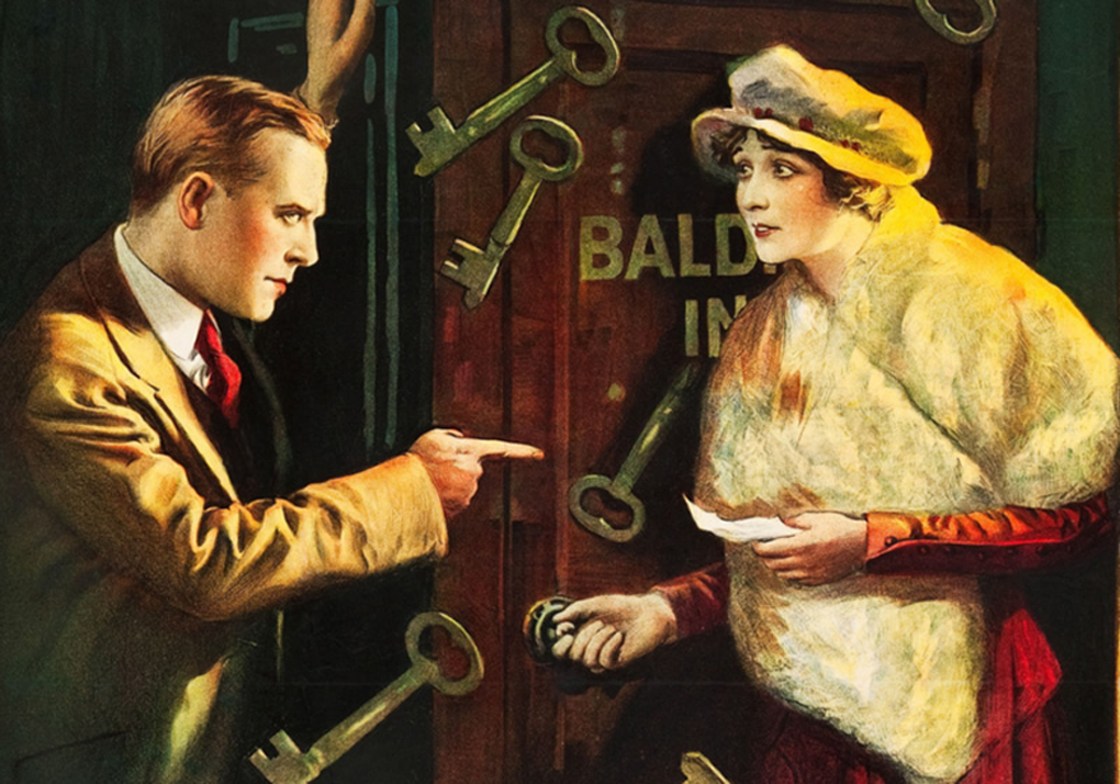


Fritzi, I definitely see why HOUSE OF LONG SHADOWS didn’t wow you — though I AM pleased to see you have a guest shot with our pal Jo Gabriel, who’s always a delight! 😀 I was also tickled to see that Hedda Hopper was in the film, if only because I’m a fan of Perry Mason and William Hopper! Desi Arnaz Jr.? Really? Oh well, Desi has to eat, too! Anyway, I really enjoyed your post, as always! 😀
Thanks! Yes, Jo was a great help in getting everything sorted out with the talkie 🙂